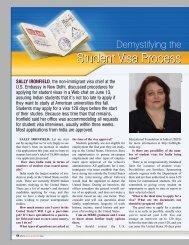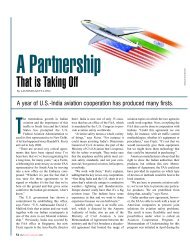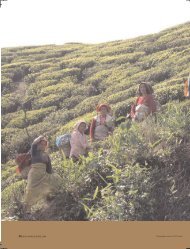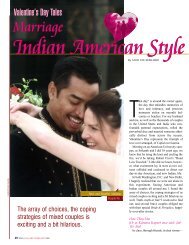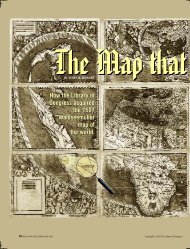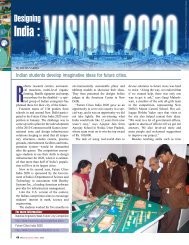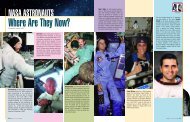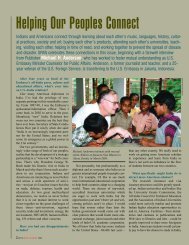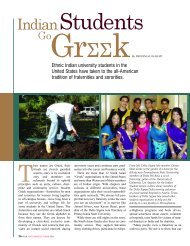Young Volunteers SPAN
Young Volunteers SPAN
Young Volunteers SPAN
Create successful ePaper yourself
Turn your PDF publications into a flip-book with our unique Google optimized e-Paper software.
<strong>Young</strong><strong>Volunteers</strong><br />
By DEEPANJALI KAKATI<br />
Asharp breeze cuts through the<br />
swaying grass but fails to dampen<br />
the enthusiasm of a bunch of students<br />
from New Delhi’s Sanskriti<br />
School as they take off their shoes<br />
and wade into the Yamuna River on a cold<br />
December morning. They have come to<br />
chart the course of the river and understand<br />
how its relatively clean water turns totally<br />
murky as soon as it enters the city.<br />
Vimlendu Jha, who designed this course<br />
on environment education for three schools<br />
in New Delhi, rolls out the shocking facts—<br />
more than three billion liters of chemical<br />
waste and untreated sewage get dumped each<br />
day into the Yamuna, the source of 70 percent<br />
of the city’s drinking water. The responsibility<br />
for cleaning it up, he says, lies not<br />
only with the government but also with common<br />
people like you and me.<br />
The awareness trip is part of Bridge the<br />
Gap, an environment education course running<br />
in Vasant Valley, Shri Ram and<br />
Sanskriti schools in New Delhi. Bridge the<br />
Gap tries to help students understand their<br />
ecological environment and develop a sense<br />
of responsibility for it. “We work with rich<br />
schools from where we earn our resources<br />
and spend it in poor schools where we do it<br />
for free,” says Jha, explaining the cross-subsidizing<br />
format.<br />
After graduation from New Delhi’s St.<br />
Stephen’s College in 2000, Jha postponed<br />
further studies in order to launch the We for<br />
Yamuna campaign. Disgusted with the condition<br />
of the river, he started the movement<br />
with 10 people to create awareness about<br />
how the Yamuna was being polluted and<br />
what needed to be done to clean it up. Within<br />
a few months, they were able to mobilize<br />
more than 500 volunteers.<br />
The organization has now grown into a<br />
full-fledged NGO called Swechha—We for<br />
2 <strong>SPAN</strong> JANUARY/FEBRUARY 2007<br />
Nonprofit organizations help<br />
youngsters promote social change<br />
and realize their potential through<br />
innovative programs.<br />
Vimlendu Jha tells<br />
students from New<br />
Delhi’s Sanskriti School<br />
how the Yamuna River<br />
gets polluted.
HEMANT BHATNAGAR
Change Foundation, which is active in the<br />
fields of environmental conservation,<br />
empowerment and social consciousness.<br />
Swechha has engaged with more than 5,000<br />
young volunteers in the past six years. “One<br />
form of volunteering is when we work for<br />
you or for your cause. The other form is<br />
when volunteers are given a message and<br />
they take it forward on their own. It’s a very<br />
interesting model where the target of change<br />
becomes the vehicle of change,” says Jha.<br />
Among the many organizations promoting<br />
social change through youth volunteerism<br />
is the New Delhi-based Pravah.<br />
Started in 1992 by a group of young professionals,<br />
it works with students as well as<br />
teachers to build social responsibility. Its<br />
programs enable young people to understand<br />
and debate social issues.<br />
Pravah’s SMILE program (Students<br />
Students from New Delhi schools take part<br />
in a drive to clean up the Yamuna River<br />
on International <strong>Volunteers</strong> Day on<br />
December 5, 2006.<br />
Mobilisation Initiative for Learning through<br />
Exposure) helps people aged 17 to 25 volunteer<br />
with urban and rural NGOs, address<br />
social issues through youth clubs and influence<br />
public opinion through campaigns.<br />
The program is operational in 15 colleges in<br />
New Delhi and 22 other cities in India.<br />
Whether it is street plays to raise awareness<br />
about civic responsibilities or initiating<br />
dialogues on sexual harassment in public<br />
transport, the youngsters spread the<br />
message with creativity and enthusiasm.<br />
Each volunteer is expected to put in at least<br />
80 hours of work in New Delhi and spend<br />
4 <strong>SPAN</strong> JANUARY/FEBRUARY 2007<br />
four to six weeks outside the capital.<br />
Swechha’s programs are driven forward<br />
by enthusiastic youngsters, too. “<strong>Young</strong><br />
people just need the right platform and<br />
somebody needs to channel their energy,”<br />
says Jha, who is 27. “One very important<br />
thing we do in most of our volunteering<br />
programs is that we try to make people<br />
realize their self-worth—who am I, how<br />
am I different, what is my potential and<br />
where do I place myself in society.”<br />
Self-development is a key element of<br />
volunteerism and participants are often<br />
driven by the desire to bring about positive<br />
changes in their surroundings. In the<br />
process, they learn to work in groups and to<br />
communicate. While many do it just to help<br />
the less fortunate or spread a social message,<br />
volunteering has also become a good<br />
way for students to build up their resumes,<br />
learn new skills or make contacts that can<br />
help them in their careers.<br />
Sushant Arora, a SMILE volunteer, was<br />
part of the team that made the short film It<br />
Matters for the 2003 campaign Operation<br />
Ballot Box, to encourage young people to<br />
vote. “The film stands out as one experience<br />
that not only allows me to boast about<br />
having made a film in the very first year of<br />
my graduation studies, but also gives me an<br />
edge over others in terms of the knowledge<br />
I gained in the process,” says Arora.<br />
Swechha’s programs also tap youthful<br />
energy in different ways. Last year the<br />
Monsoon Wooding program brought together<br />
more than 200 young volunteers who dis-<br />
Courtesy Vimlendu Jha<br />
tributed saplings throughout New Delhi and<br />
encouraged people through street plays to<br />
rejuvenate the city’s green cover. The program<br />
includes an informal school, called the<br />
Pagdandi School, run by university student<br />
volunteers who teach children in slums and<br />
promote awareness about sanitation and<br />
health. Swechha’s music band, Jigri, gives<br />
voice to its message of social responsibility.<br />
Jha also takes school students on fourday<br />
exposure trips to rural areas to make<br />
them aware of the symbiotic relationship<br />
between urban and rural India. One such<br />
trip to Mussoorie in September taught<br />
Ameesh Bhatnagar of Shri Ram School the<br />
basics of rural life. Staying with the villagers<br />
and helping out with their daily<br />
chores made him “appreciate the privileges<br />
I was accustomed to and how urban society<br />
is dependent on village resources,” he says.<br />
“Mahatma Gandhi talked about how<br />
there’s enough for everybody’s need but not<br />
enough for somebody’s greed. For us, success<br />
means as much as you can consume<br />
and waste. But is that ideal for our planet, is<br />
that ideal for our social institutions? That’s<br />
what our programs talk about,” says Jha.<br />
Pravah’s rural exposure trips for urban<br />
schoolchildren help them break stereotypes<br />
and understand concepts like sustainable<br />
development and equitable distribution of<br />
resources. At times, these camps also turn<br />
into revelatory experiences for the volunteers<br />
looking after the students.<br />
Neha Buch, a volunteer at one such camp<br />
in Wardha, Maharashtra, remembers a quiet<br />
girl from New Delhi’s Sanskriti School who<br />
mostly kept to herself. On the last day, Buch<br />
saw the girl making a temporary road in the<br />
village. To her surprise, she saw this girl<br />
carrying a basket of cow dung, laying it on<br />
the path, leveling it with her hands and then<br />
jumping up and down to press the dung into<br />
place. Buch still hasn’t forgotten the look of<br />
pure joy on the girl’s face. “That was the<br />
first time I felt at peace….The reason why I<br />
was doing what I was doing sank in. I know<br />
each person has a true potential. They just<br />
need a chance to realize it,” she says.<br />
Pravah’s SMILE program is divided into<br />
three stages that encourage the volunteers<br />
to learn from each other’s experiences. As<br />
a first step, they meet and bond with their<br />
fellow volunteers. In the next stage, they<br />
are taken out of New Delhi for three to six<br />
International Visitor Leadership Program: http://exchanges.state.gov/education/ivp/
weeks where they get a chance to connect<br />
with other communities and learn about<br />
their social realities. The concluding stage<br />
is one of reflection, where the young participants<br />
share their experiences.<br />
An extension of Pravah’s involvement<br />
with youth is the Bridging Universities to<br />
Societies initiative with Ashoka Innovators<br />
for the Public, based in Arlington, Virginia,<br />
in the United States. The initiative promotes<br />
entrepreneurship among youth and<br />
students in India.<br />
On a visit to the United States under the<br />
State Department’s International Visitor<br />
Leadership Program in 2005, Jha learned<br />
how voluntary organizations in America<br />
engage with young people on issues of ecology.<br />
“I learnt a lot, traveling to different<br />
Above: Pravah’s<br />
student volunteers<br />
from New Delhi help<br />
villagers in Rajasthan<br />
with their daily work.<br />
Left: <strong>Volunteers</strong><br />
from Pravah stage a<br />
street play on the<br />
right to shelter in<br />
front of a multiplex<br />
in New Delhi.<br />
places, understanding different cultures,<br />
understanding different ways of looking at<br />
things. The IVLP program was quite an<br />
eye-opener,” he says.<br />
The journey indeed is most often one of<br />
self-discovery and realization. Journalist<br />
Newly Paul from New Delhi, who went on<br />
a Pravah awareness trip to Shahbad village<br />
in Rajasthan as a college student, says, “All<br />
these years I had read of poverty, drought<br />
and illiteracy as chapters in a book. But this<br />
exposure has changed my views completely.<br />
Each of these words is now alive for<br />
me—associated with those hopeful faces<br />
that I saw in the village.”<br />
Sweta Roy Kashyap, research fellow<br />
with the Indian Agricultural Research<br />
Institute in New Delhi, took up voluntary<br />
work in Bihar’s Munger district with the<br />
Self Employed Women’s Association, looking<br />
for “real satisfaction and an opportunity<br />
to work directly with people.” Though she<br />
complains about the entry of people without<br />
the necessary level of commitment into this<br />
sector, Kashyap says that her experience<br />
helped her “grow and evolve as a person.”<br />
Volunteering as a youngster, in fact,<br />
encourages people to dedicate their time<br />
and energy for others later on. Rashmi<br />
Sarmah, a Guwahati-based journalist, fondly<br />
recalls the time she spent working with<br />
sick animals as a volunteer with the Society<br />
for the Prevention of Cruelty to Animals<br />
(SPCA) in Baroda, Gujarat, during her college<br />
years. When she landed in the United<br />
States after college and wanted to take a<br />
break from her job at a news channel, she<br />
chose to volunteer at the Signal Mountain<br />
Animal Shelter and an assisted living facility<br />
for the elderly called Manor House in<br />
Chattanooga, Tennessee.<br />
“My experience at the SPCA shelter<br />
encouraged me to go ahead with something<br />
similar there,” she says. Spending time<br />
with the elderly people also helped her feel<br />
less homesick. “The most rewarding<br />
moments were when they would eagerly<br />
want to listen to stories from India and also<br />
tell me about their childhood days.”<br />
Please share your views on this article by<br />
writing to editorspan@state.gov<br />
<strong>SPAN</strong> JANUARY/FEBRUARY 2007 5<br />
Photographs courtesy Pravah




